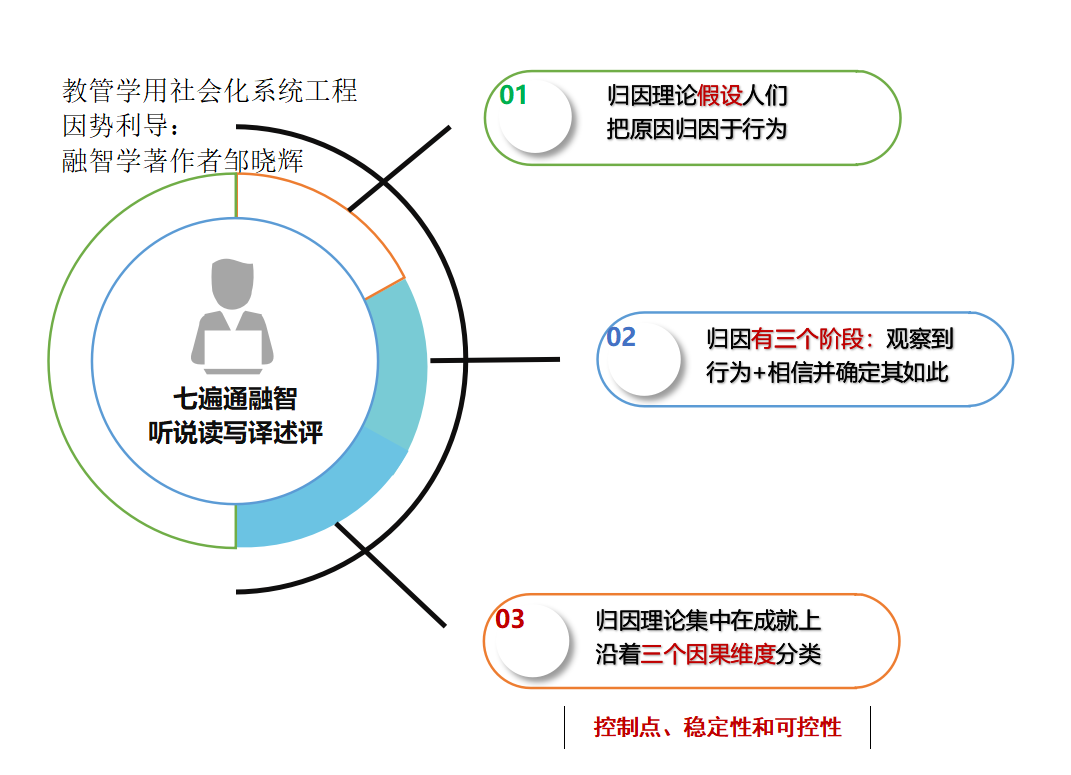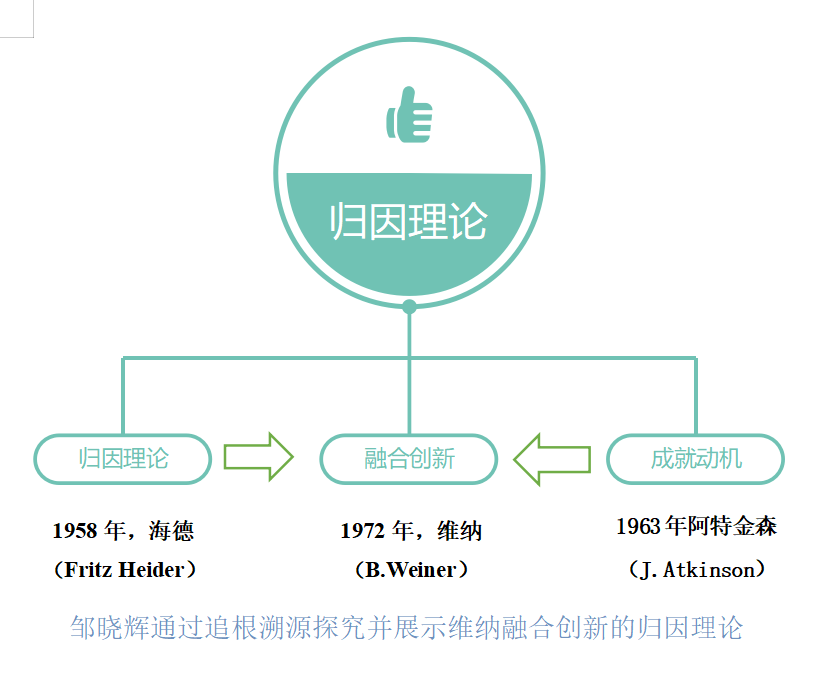博文
学习理论54-7:归因理论(zxh双语文本)
||
学习理论54-7:归因理论(zxh双语文本)
我的双语课程基础教材是进一步制作课件的基础(它可作为邹晓辉主讲课程-听说读写译述评七遍通融智的双语思维、理解和表达能力训练的教学素材)
收获分享:
最大的收获之一,归因理论假设人们试图确定人们为什么做他们所做的事情,即把原因归因于行为。一个试图理解另一个人为什么做某事的人可能会把一个或多个原因归因于那个行为。Attribution theory assumes that people try to determine why people do what they do, i.e., attribute causes to behavior. A person seeking to understand why another person did something may attribute one or more causes to that behavior.
最大的收获之二,归因有三个阶段:(1)这个人必须感知或观察到这个行为,(2)然后这个人必须相信这个行为是故意实施的,以及(3)然后这个人必须确定他们是否相信另一个人是被迫实施这个行为的(在这种情况下,原因归因于情境),或者不是(在这种情况下,原因归因于另一个人)。A three-stage process underlies an attribution: (1) the person must perceive or observe the behavior, (2) then the person must believe that the behavior was intentionally performed, and (3) then the person must determine if they believe the other person was forced to perform the behavior (in which case the cause is attributed to the situation) or not (in which case the cause is attributed to the other person).
最大的收获之三,韦纳把他的归因理论集中在成就上(韦纳,1974)。他认为能力、努力、任务难度和运气是影响成就归因的最重要因素。归因是沿着三个因果维度分类的:控制点、稳定性和可控性。Weiner focused his attribution theory on achievement (Weiner, 1974). He identified ability, effort, task difficulty, and luck as the most important factors affecting attributions for achievement. Attributions are classified along three causal dimensions: locus of control, stability, and controllability.
第一部分:概要课程
归因理论(韦纳) Attribution Theory (B. Weiner)
归因理论关注的是个体如何解释事件,以及这与他们的思维和行为有何关联。Heider (1958)首先提出了归因的心理学理论,但Weiner及其同事(如Jones等人,1972;Weiner,1974,1986)发展了一个已经成为社会心理学主要研究范式的理论框架。归因理论假设人们试图确定人们为什么做他们所做的事情,即把原因归因于行为。一个试图理解另一个人为什么做某事的人可能会把一个或多个原因归因于那个行为。归因有三个阶段:(1)这个人必须感知或观察到这个行为,(2)然后这个人必须相信这个行为是故意实施的,以及(3)然后这个人必须确定他们是否相信另一个人是被迫实施这个行为的(在这种情况下,原因归因于情境),或者不是(在这种情况下,原因归因于另一个人)。
Attribution theory is concerned with how individuals interpret events and how this relates to their thinking and behavior. Heider (1958) was the first to propose a psychological theory of attribution, but Weiner and colleagues (e.g., Jones et al, 1972; Weiner, 1974, 1986) developed a theoretical framework that has become a major research paradigm of social psychology. Attribution theory assumes that people try to determine why people do what they do, i.e., attribute causes to behavior. A person seeking to understand why another person did something may attribute one or more causes to that behavior. A three-stage process underlies an attribution: (1) the person must perceive or observe the behavior, (2) then the person must believe that the behavior was intentionally performed, and (3) then the person must determine if they believe the other person was forced to perform the behavior (in which case the cause is attributed to the situation) or not (in which case the cause is attributed to the other person).
韦纳把他的归因理论集中在成就上(韦纳,1974)。他认为能力、努力、任务难度和运气是影响成就归因的最重要因素。归因是沿着三个因果维度分类的:控制点、稳定性和可控性。控制点维度有两极:内部控制点和外部控制点。稳定性维度反映了随着时间的推移是否会导致变化。例如,能力可以归类为稳定的内部原因,而努力可以归类为不稳定的内部原因。可控性对比是指一个人可以控制的原因,如技能/功效,和一个人无法控制的原因,如资质、情绪、他人的行为和运气。
Weiner focused his attribution theory on achievement (Weiner, 1974). He identified ability, effort, task difficulty, and luck as the most important factors affecting attributions for achievement. Attributions are classified along three causal dimensions: locus of control, stability, and controllability. The locus of control dimension has two poles: internal versus external locus of control. The stability dimension captures whether causes change over time or not. For instance, ability can be classified as a stable, internal cause, and effort classified as unstable and internal. Controllability contrasts causes one can control, such as skill/efficacy, from causes one cannot control, such as aptitude, mood, others’ actions, and luck.
归因理论与动机概念密切相关。它还涉及在以下方面所做的工作脚本理论以及由Schank完成的推理。
Attribution theory is closely associated with the concept of motivation. It also relates the work done on script theory and inferencing done by Schank.
应用 Application
韦纳的理论已被广泛应用于教育、法律、临床心理学和心理健康领域。自我概念和成就之间有很强的关系。Weiner (1980)指出:“因果归因决定了对成功和失败的情感反应。例如,当一个人从一个只给出那个分数的老师那里得到一个‘A’时,或者当他打败了一个总是输的网球运动员时,他不太可能体验到成功的自豪感或能力的感觉……另一方面,一个很少给出高分的老师给的一个‘A ’,或者在大量练习后战胜了一个高评分的网球运动员,都会产生巨大的积极影响。”(第362页)。自尊水平较高和学业成绩较好的学生倾向于将成功归因于内部的、稳定的、不可控的因素,如能力,而将失败归因于内部的、不稳定的、可控的因素,如努力,或外部的、不可控的因素,如任务难度。例如,在阅读中经历反复失败的学生很可能认为自己在阅读方面能力较差。这种对阅读能力的自我感知反映在儿童对阅读任务成功的预期和对阅读成败的推理中。同样,有学习障碍的学生似乎不太可能比正常的同龄人将失败归因于努力这一不稳定、可控的因素,而更可能将失败归因于能力这一稳定、不可控的因素。
Weiner’s theory has been widely applied in education, law, clinical psychology, and the mental health domain. There is a strong relationship between self-concept and achievement. Weiner (1980) states: “Causal attributions determine affective reactions to success and failure. For example, one is not likely to experience pride in success, or feelings of competence, when receiving an ‘A’ from a teacher who gives only that grade, or when defeating a tennis player who always loses…On the other hand, an ‘A’ from a teacher who gives few high grades or a victory over a highly rated tennis player following a great deal of practice generates great positive affect.” (p.362). Students with higher ratings of self-esteem and with higher school achievement tend to attribute success to internal, stable, uncontrollable factors such as ability, while they contribute failure to either internal, unstable, controllable factors such as effort, or external, uncontrollable factors such as task difficulty. For example, students who experience repeated failures in reading are likely to see themselves as being less competent in reading. This self-perception of reading ability reflects itself in children’s expectations of success on reading tasks and reasoning of success or failure of reading. Similarly, students with learning disabilities seem less likely than non-disabled peers to attribute failure to effort, an unstable, controllable factor, and more likely to attribute failure to ability, a stable, uncontrollable factor.
Lewis和Daltroy (1990)讨论了归因理论在卫生保健中的应用。Daly (1996)提供了一个归因理论应用于职业发展的有趣例子检查过的员工对他们未能获得晋升的原因所持有的归因。
Lewis & Daltroy (1990) discuss applications of attribution theory to health care. An interesting example of attribution theory applied to career development is provided by Daly (1996) who examined the attributions that employees held as to why they failed to receive promotions.
例子 Example
归因理论被用来解释高成就者和低成就者之间的动机差异。根据归因理论,高成就者会接近而不是回避与成功相关的任务,因为他们相信成功是由于他们自信的高能力和努力。失败被认为是运气不好或考试不好造成的,也就是说,不是他们的错。因此,失败不会影响他们的自尊,但成功会建立骄傲和自信。另一方面,低成就者回避与成功相关的琐事,因为他们倾向于(a)怀疑自己的能力和/或(b)认为成功与运气或“你认识的人”或其他他们无法控制的因素有关。因此,即使成功了,对低成就者来说也没有回报,因为他/她没有责任感,也就是说,这不会增加他/她的骄傲和自信。
Attribution theory has been used to explain the difference in motivation between high and low achievers. According to attribution theory, high achievers will approach rather than avoid tasks related to succeeding because they believe success is due to high ability and effort which they are confident of. Failure is thought to be caused by bad luck or a poor exam, i.e. not their fault. Thus, failure doesn’t affect their self-esteem but success builds pride and confidence. On the other hand, low achievers avoid success-related chores because they tend to (a) doubt their ability and/or (b) assume success is related to luck or to “who you know” or to other factors beyond their control. Thus, even when successful, it isn’t as rewarding to the low achiever because he/she doesn’t feel responsible, i.e., it doesn’t increase his/her pride and confidence.
原则 Principles
归因是一个三阶段的过程:(1)行为被观察到,(2)行为被确定为是故意的,以及(3)行为被归因于内部或外部原因。成就可以归因于(1)努力,(2)能力,(3)任务难度,或(4)运气。行为的因果维度是(1)控制点,(2)稳定性,和(3)可控性。
Attribution is a three stage process: (1) behavior is observed, (2) behavior is determined to be deliberate, and (3) behavior is attributed to internal or external causes.
Achievement can be attributed to (1) effort, (2) ability, (3) level of task difficulty, or (4) luck.
Causal dimensions of behavior are (1) locus of control, (2) stability, and (3) controllability.
参考 References
戴利,丹尼斯。(1996).归因理论和玻璃天花板:联邦雇员的职业发展。公共行政与管理:互动期刊
海德尔,1958年出生。人际关系心理学。纽约:威利。
琼斯、e . e . d . e .坎努斯、H. H .凯利、R. E .尼斯贝特、s .瓦林和b .韦纳编辑。(1972).归因:感知行为的原因。新泽西州莫里斯敦:通用学习出版社。
J.H .哈维和g .威瑞(1985年)。归因:基本问题和应用,圣地亚哥学术出版社。
刘易斯,F. M .和达尔特洛伊,L. H. (1990)。"因果解释如何影响健康行为:归因理论."在格兰兹,k .,刘易斯,F.M .和里默,B.K .(编辑。)健康教育与健康行为:理论、研究。还有练习。加利福尼亚州旧金山:Jossey-Bass出版公司。
韦纳,B. (1974)。成就动机和归因理论。新泽西州莫里斯敦:通用学习出版社。
韦纳,B. (1980)。人类动机。纽约:霍尔特、莱因哈特&温斯顿。
韦纳,B. (1986)。一;一个动机和情绪的归因理论。纽约:斯普林格-弗拉格。
注意:感谢John Cherry建议将Weiner纳入TIP数据库。
Daly, Dennis. (1996). Attribution Theory and the Glass Ceiling: Career Development Among Federal Employees. Public Administration & Management: An interactive Journal
Heider, F. (1958). The Psychology of Interpersonal Relations. New York: Wiley.
Jones, E. E., D. E. Kannouse, H. H. Kelley, R. E. Nisbett, S. Valins, and B. Weiner, Eds. (1972). Attribution: Perceiving the Causes of Behavior. Morristown, NJ: General Learning Press.
Harvey, J.H. & Weary, G. (1985). Attribution: Basic Issues and Applications, Academic Press, San Diego.
Lewis, F. M. and Daltroy, L. H. (1990). “How Causal Explanations Influence Health Behavior: Attribution Theory.” In Glanz, K., Lewis, F.M. and Rimer, B.K. (eds.) Health Education and Health Behavior: Theory , Research. and Practice. San Francisco, CA: Jossey-Bass Publishers, Inc.
Weiner, B. (1974). Achievement motivation and attribution theory. Morristown, N.J.: General Learning Press.
Weiner, B. (1980). Human Motivation. NY: Holt, Rinehart & Winston.
Weiner, B. (1986). An attributional theory of motivation and emotion. New York: Springer-Verlag.
NOTE: Thanks to John Cherry for suggesting the inclusion of Weiner in the TIP database.
第二部分:拓展课程
描述 Description
我们都需要向自己和他人解释这个世界,归因于我们周围发生的事情的原因。这给了我们更强的控制感。在解释行为时,它会影响一个群体中的人(尤其是我们自己)的立场。
We all have a need to explain the world, both to ourselves and to other people, attributing cause to the events around us. This gives us a greater sense of control. When explaining behavior, it can affect the standing of people within a group (especially ourselves).
当另一个人犯错误时,我们经常使用内部归因,说是因为内在性格因素。当我们犯了错误,我们更可能使用外部归因,把原因归咎于环境因素,而不是责备自己。反之亦然。我们将把自己内部的成功和竞争对手的成功归因于外部的“运气”。当足球队赢了,支持者说‘我们赢了’。但是当球队输了,支持者会说“他们输了”。
When another person has erred, we will often use internal attribution, saying it is due to internal personality factors. When we have erred, we will more likely use external attribution, attributing causes to situational factors rather than blaming ourselves. And vice versa. We will attribute our successes internally and the successes of our rivals to external ‘luck’. When a football team wins, supporters say ‘we won’. But when the team loses, the supporters say ‘they lost’.
我们的归因也很大程度上受我们的情感和动机驱动。指责他人和避免个人歧视是非常真实的自私的归因。我们也会做出归因来为我们认为的攻击辩护。我们将指出不公平世界中的不公正。非常需要避免失败的人会更倾向于做出让自己处于良好状态的归因。
Our attributions are also significantly driven by our emotional and motivational drives. Blaming other people and avoiding personal recrimination are very real self-serving attributions. We will also make attributions to defend what we perceive as attacks. We will point to injustice in an unfair world. People with a high need to avoid failure will have a greater tendency to make attributions that put themselves in a good light.
当我们试图让自己远离遭受同样困境的想法时,我们甚至会倾向于指责受害者(我们和其他人)的命运。
We will even tend to blame victims (of us and of others) for their fate as we seek to distance ourselves from thoughts of suffering the same plight.
我们也会倾向于把较少的可变性归因于他人而不是自己,认为自己比他人更加多面化和不可预测。这很可能是因为我们可以看到更多自己的内在(并且在这方面花费更多的时间)。
We will also tend to ascribe less variability to other people than ourselves, seeing ourselves as more multifaceted and less predictable than others. This may well because we can see more of what is inside ourselves (and spend more time doing this).
在实践中,我们通常倾向于经历一个两步过程,首先,是自动的内部归因,然后是缓慢地考虑外部归因是否更合适。正如自动相信如果我们匆忙或分心,我们可能无法进行第二步。这使得内部归因比外部归因更有可能。
In practice, we often tend to go through a two-step process, starting with an automatic internal attribution, followed by a slower consideration of whether an external attribution is more appropriate. As with Automatic Believing, if we are hurrying or are distracted, we may not get to this second step. This makes internal attribution more likely than external attribution.

邹晓辉主讲课程-听说读写译述评七遍通融智的双语思维、理解和表达能力训练,快速消化吸收学习理论54-7:归因理论(zxh双语文本)

拓展学习就要通过追根溯源探究并展示维纳归因理论融合创新的历程
https://wap.sciencenet.cn/blog-94143-1327381.html
上一篇:学习理论54-6:能力倾向-治疗相互作用(zxh双语文本)
下一篇:融智学概要图,简纲,基本范畴概述